Euphoria and Irreverence
On Fred Astaire and Ginger Rogers
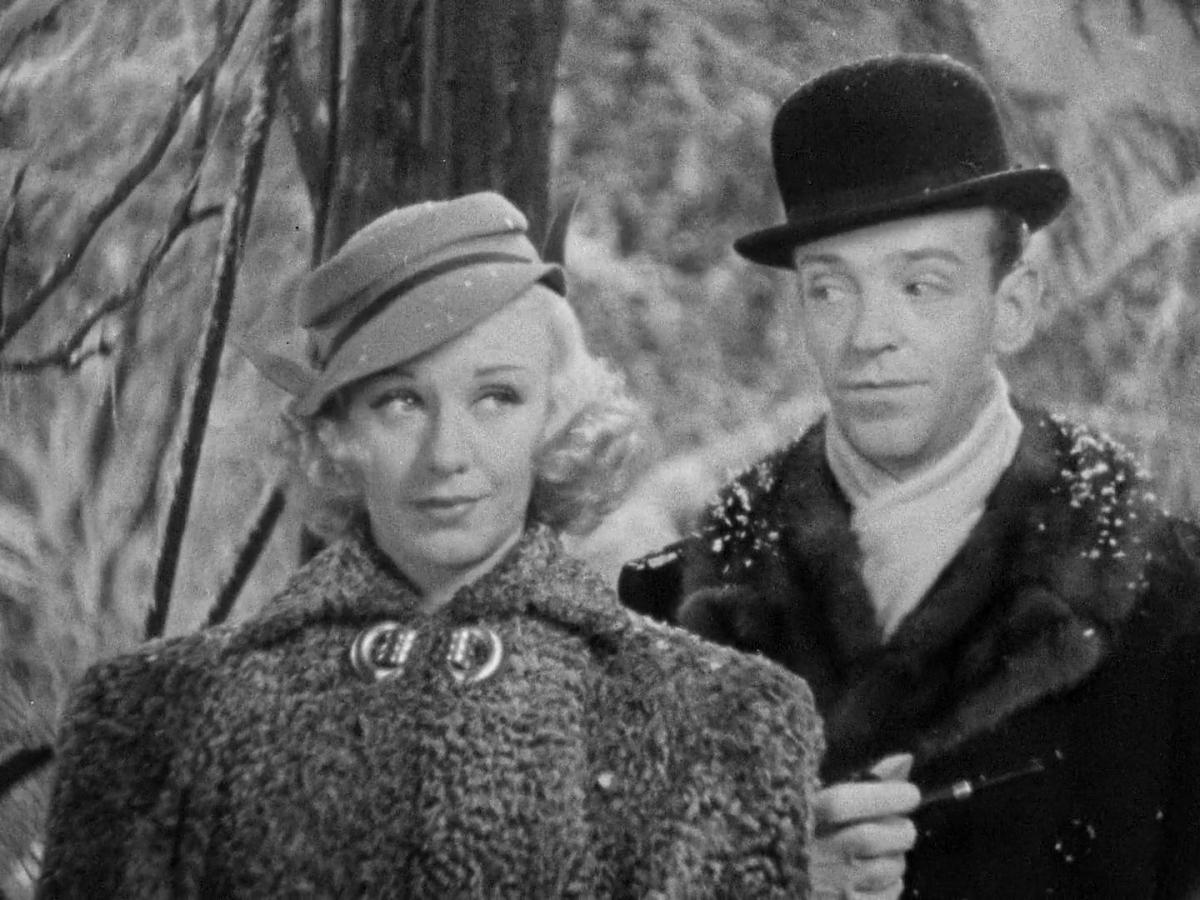
Exaltation tempered by perplexity – those were the two poles between which the films1 featuring Fred Astaire and Ginger Rogers kept me wedged as a spectator.2 Exaltation at songs, dance acts, comic interludes immediately followed by bewilderment, because all this did not establish a homogeneous, constant, recognisable spectator figure in me. What do these films want from me? What audience do they want? What form of address do they wield? What place have they provided in their text for the spectator, for me?
What occupies my mind is precisely the heterogeneity of these films. Nearly everyone expresses this observation by reproaching the story for being so banal, stereotypical, improbable. But the things you get in return! The enormous success of the series in the 1930s, the prestige of the classic dance musical.3 The enduring popularity of some of the films from the series, their enormous significance for the development of the musical as a genre, the motifs, myths and values, the dance concept. And not least the creation of the Astairian character, in large part the linchpin of the genre.
This line of development has been pointed out and elaborated on many times. What continues to occupy my mind is the character of the series itself, both through its effect on me as a spectator and the construction of the films. What are these films like, and what do they do when I discipline myself, despite my perplexity, in order to discover some of their unity, their own particular register, the homogeneity they must somehow have if they are to be understood as texts. In other words, I stand before a text whose grammar and lexicon are partly very familiar to me and otherwise seem as if they have been written in secret code. So I start from the assumption that it is worthwhile engaging with that coded part too. One cannot discover the principle of unity of the series itself if one limits oneself to regarding the series only as a phase in the development of the genre.
I have no formula in the meantime for the series, no principle of homogeneity at hand. I would just like to emphasise what one is very quick to forget or obscure. I would like to elaborate and briefly follow – in an unsystematic manner – the reflections, affects and details I noted while watching. No synthesis, no order, but the raking up of unruly facts (effects in the spectator, facets of the film text). The Astaire-Rogers films are: this too... and this... and this...
In doing so, I would like to place each subject, motif, adjective as a small, local, partial, relative thinking machine. Like a small test – the way artificial explosions are used in geological research to measure the vibrations from a distance and explore the composition of the earth’s crust.
I’ll make a few statements about the series, and see where they take me.
Exaltation
Above all: desires!
The desire to be with someone, to be a spectator together (as a we) (“it always takes two for an image”).4 The desire to be not an individual reader, but part of a collective. In the films themselves, this infectiousness is demonstrated so often that it spreads to the audience. This we-feeling sometimes even takes on a very intimate form: at every transition from speaking to singing, from moving to dancing.
The desire after the film to stretch out our arms and our gaze. We have suddenly become so different, for this was surely a very different world. We feel like immediately walking up and down a pavement, with a little “tap” in between (rhythm), a sway of the hips (sensuality), a gesture with the arms and hands (lyricism). These films make you want to do (rather than to be, to be emotional). Promotional material for a culture of moving?
The desire to remember immediately, too: “Do you remember when.... that scene...?” And then you notice how much has already been forgotten. Panic.
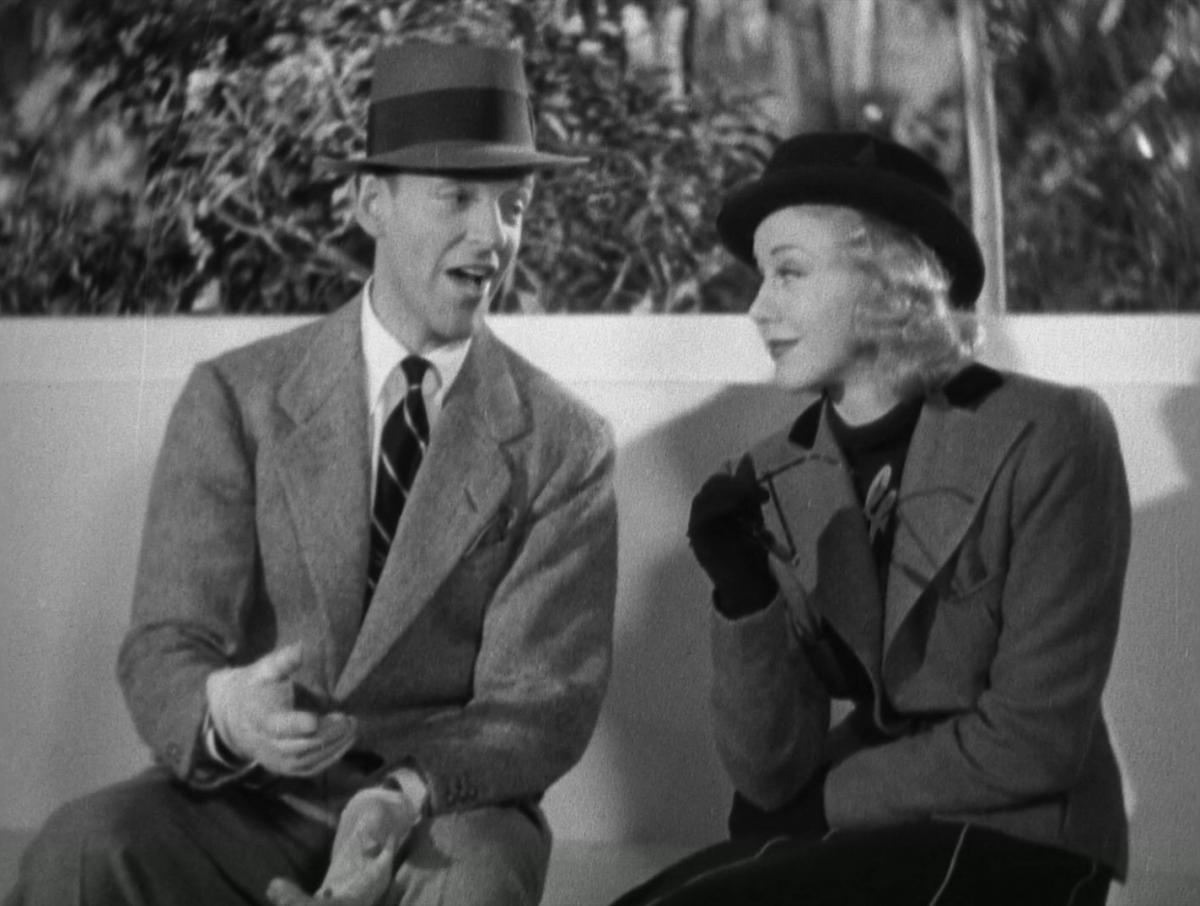
Forgotten
The complaint about the plot of the films is bizarre, because we pretty much forget all narrative information while watching. It is one of the very mechanisms of the comical. It constantly makes the characters themselves forget (The Gay Divorcee), it distracts attention (Swing Time), and it makes itself forget (Carefree). After a mere half hour of film, the audience does not remember that Astaire is a professional dancer (The Gay Divorcee, Top Hat, Swing Time, Shall We Dance). Does it matter that Rogers is a model for a couturier (Top Hat), a radio star (Carefree) or the wife of a geologist (The Gay Divorcee)? And do they really travel from Paris to London (The Gay Divorcee), from London to Venice (Top Hat) or from Paris to New York (Shall We Dance)? You are vaguely aware of the plot’s time structure (but the time experience in these films is extremely intriguing). It is all so feather-light, so without consequence, that the viewer should not feel lost but liberated from the usual emphatic, novelistic plot structure. Anyway, in film culture, the novelistic tradition has gained absolute ascendancy over that other tradition, that of shows, variety, vaudeville and revues.
Permutations
“You say eether and I say eyether.”5
This is a digital world, ruled by a long circuit of ins and outs. Everything is ruled by extremely clear dichotomies: connected/disconnected, rich/non-rich, married/non-married, man/woman, blond/dark, old/young, thin/heavy, in love/single, big/small, serious/funny. Everything is like the running gag in Shall We Dance, in which Astaire and Rogers balance between married/non-married and, depending on the position of the switch, may or may not have the key that opens the door between their hotel suites.
This digital nature of the series obviously has to do with its narrative lightness. Both the affective (is one in love?) and institutional (is one engaged, married, divorced?) sides of love are juggled without hesitation. The denouement in Swing Time, what with the double breaking off of an engagement and the exuberant “There isn’t going to be any wedding!”, is the culmination of these lighthearted (just not cynical) love acrobatics.
This is a world ruled by rhyme, echo, duplication and deduplication, pontification and denial. Take, for instance, ‘A Fine Romance’ (Swing Time) and all its built-in contrasts: a trip outside (in winter) to a dilapidated “New Amsterdam”, two people in love rejecting each other, two women who want to be alone with their partners and two men who don’t want to lose sight of each other etc.
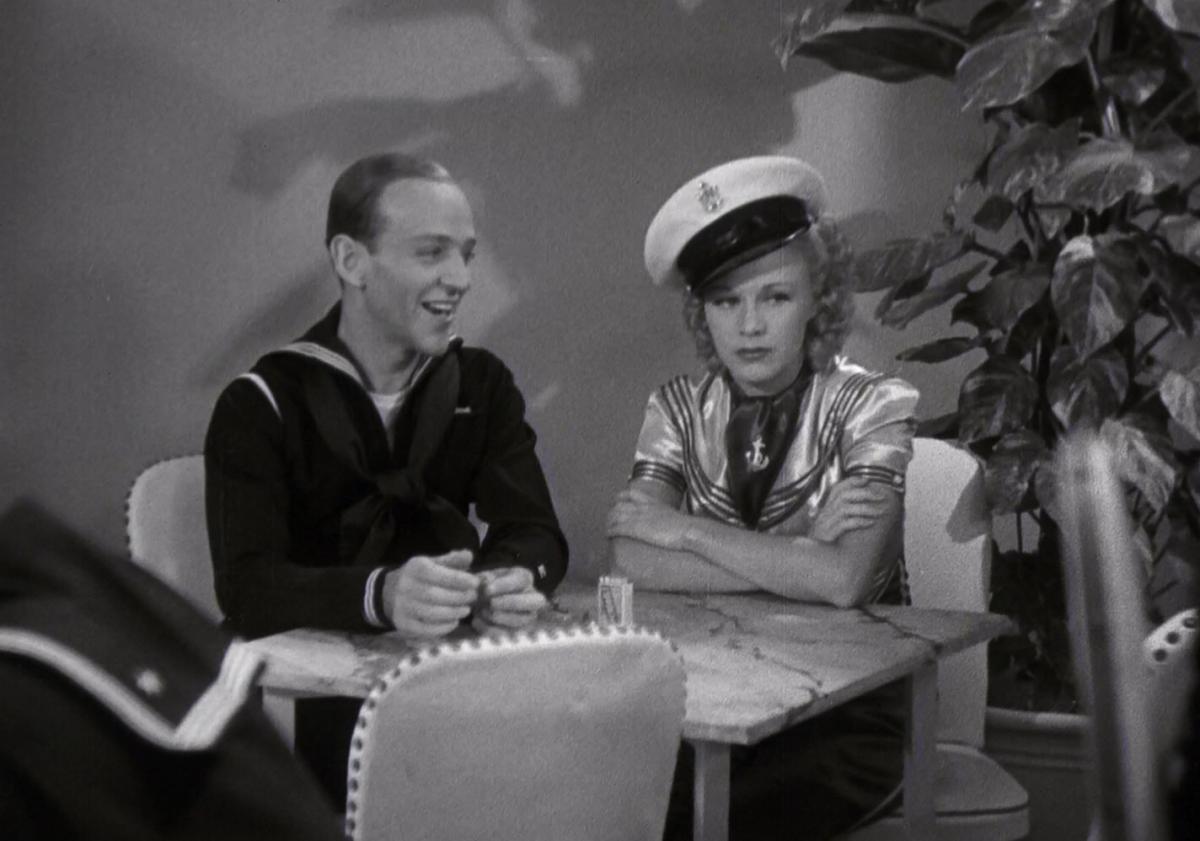
Series
The Astaire-Rogers cycle is a series. Six films in, signs of fatigue were visible.6 Less than four years to set up a duo, build a narrative formula, form a technical crew. A well-defined decade (nine of the ten films were shot in the thirties): a single studio (RKO), one genre, one team. Competence guaranteed, which is also the source of the series’ limitations (everyone mainly develops their own speciality). The high technicality required by song and dance (both in the conception, the performance and the filming) is another source of “limitation”. The musical-film genre is extremely labour intensive: it is difficult, expensive, costly, heavy and unwieldy. Some of this “stasis” is found in the purely formal playing with permutations. There is no construction of sequences in a narrative order, there is only “switching”.
Arlene Croce points out the alternating between two scripts: a Roberta Fleet script and a Divorcee, Top Hat, Swing Time script.7 The first script involves two friends who meet again (and then usually play the comic-relief duo alongside a serious romantic duo); in the second script, Astaire and Rogers meet for the first time (discovering each other only after a misunderstanding and after an impending mismatch with another partner was prevented). This is the narrative repertory of the series, all that can be said between them within these two formulas. The scope of the series does not extend any further.
Language
There is such a thing as skill in writing good lines, like there is in coming up with film titles or advertising slogans. It is a rhetorical skill. In this series, language is a constant source of playing upon meanings, sounds and figures of speech. This motif is emphatically, literally indicated from the very outset. In The Gay Divorcee, Astaire’s statement “Chance is the fool’s name for fate” leads to a discussion on the quality and authorship of this statement, and whether it is possible to borrow it. This sequence is followed by a language game between Horton and Blore in response to a figure of speech. Erik Rhodes then drags around a myriad of distortions of Astaire’s just-quoted good line, which he got as a password. Language virtuosity is of course not a means of confession, spontaneity and directness. It is a play upon communication. Hence the fact that Astaire and Rogers, like everyone else in these films, are constantly hiding what they want to say – through denial, understatement, distraction. All communication is indirect, occurring through at least one switch, one permutation. Direct affirmation only exists in song and dance, not in the dialogues, where no one ever says “I am in love”, but always “How do I make the other person fall in love with me?”
This diversion is the place of “good lines”. Communication has ceased: they show to a third party (the audience) how they manipulate. Communication as a show.
Men Versus Women
When Astaire gives dance lessons to the sailors on the navy ship, he divides them: “Here the dames and there the guys.” This division is not just an anatomical fatality but, as appears from this dance lesson, a law of dance. Astaire’s regular choreographer Hermes Pan summarised his role during Astaire and Rogers’s separate rehearsal periods as follows: “With Fred I’d be Ginger and with Ginger l’d be Fred.”8
Astaire usually starts his films entre garçons, he is one of “the boys”. In Top Hat, Follow the Fleet and Swing Time, Astaire enters the scene surrounded by men (think of the gentlemen’s club in Top Hat and shortly afterwards Eric Blore’s double-entendre “welcome to our ménage”). Invariably, Edward Everett Horton is around to warn Astaire in a meddlesome and awkward way about cunning women. Astaire in a world of vieux garçons.
Visibly younger than Blore and Horton, however, he never pits himself against them as younger. Astaire is thirty-four when he starts the series, and his student-like, teasing jokes make him look even younger. But does age play any role in the series? As is so often the case in classic Hollywood, everyone is of an indefinable age. On the other side (of the switchboard): the women – Rogers, supported by an aunt, sister or girlfriend. On both sides, strategies, warnings, encouragement, until they cross a corridor, open a connecting door and stand before each other like prizefighters. The solidarity that emerges during the song and dance acts is a paradox. It is an improbably narrow walkway between two worlds: those of men and women.
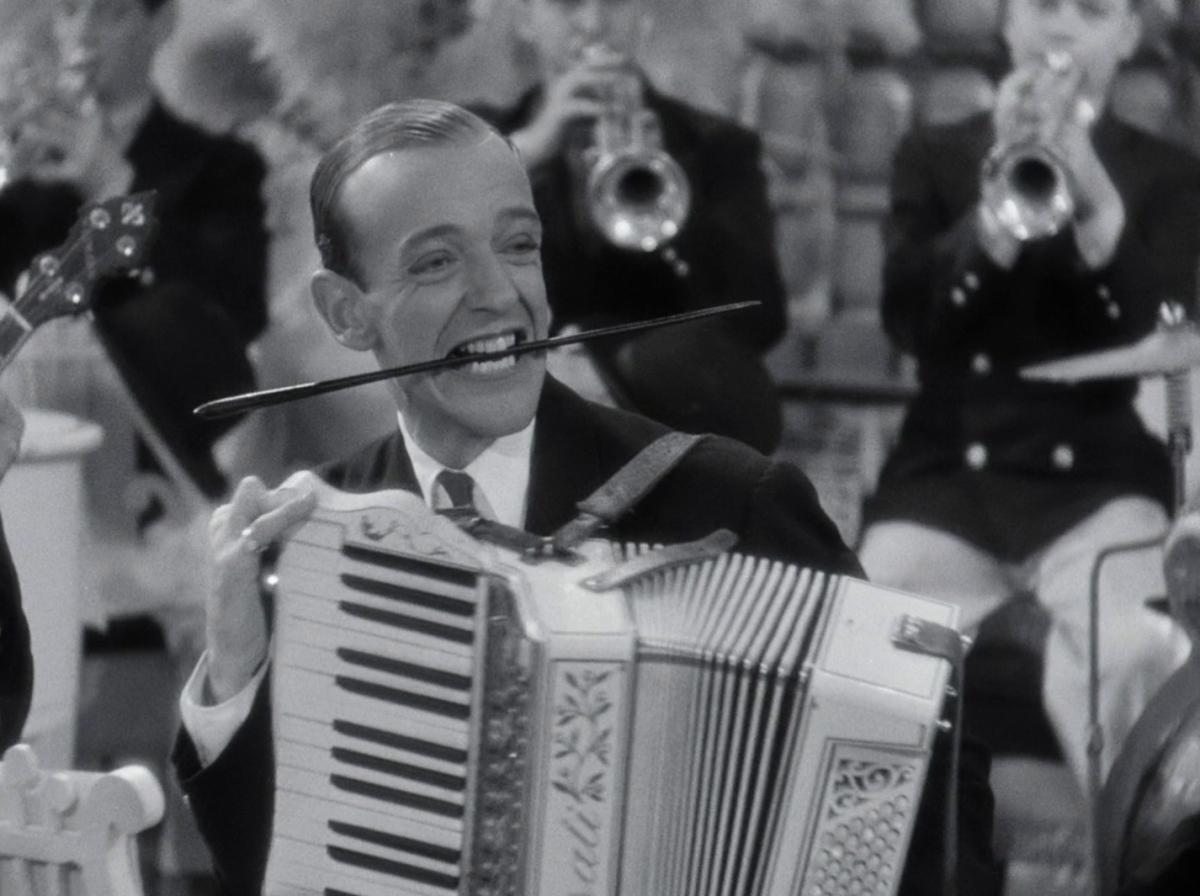
Voyeurism
Jim Collins9 cites as an example of voyeurism two shots from the ‘Night and Day’ act (The Gay Divorcee), in which the camera angle is emphasised as a “glance at”: a first shot through a window (the camera angle outside the dance space) and a second shot from under a table (in the dance space).
But these are precisely the “effect shots” that John Mueller10 notes were permanently banned from the way the dance acts were filmed after the first two films. Besides, all of Mueller’s discussion of the technique of filming dance points towards getting rid of the camera angle, which is quoted and justified (reaction shots of the diegetic audience) or made autonomous and accentuated (effect shots, multiple points of view and therefore intense editing).
Astaire’s legendary “Either I dance, or the camera dances” indicates two strategies of the gaze. Two organisations of the gaze on dance that apply not only to the intimate, sexually connoted dances, but also to all others. Astaire’s statement seems to indicate a power struggle between exhibitionist showing and voyeuristic watching (in the filming phase). But since both showing and watching, both dance and camera, are at the service of a film to be watched, of a spectator’s gaze to be caught, that is where the power struggle must be situated: who leads the spectator’s gaze? It then becomes a power struggle between two manipulative strategies: of showing and of making someone watch.
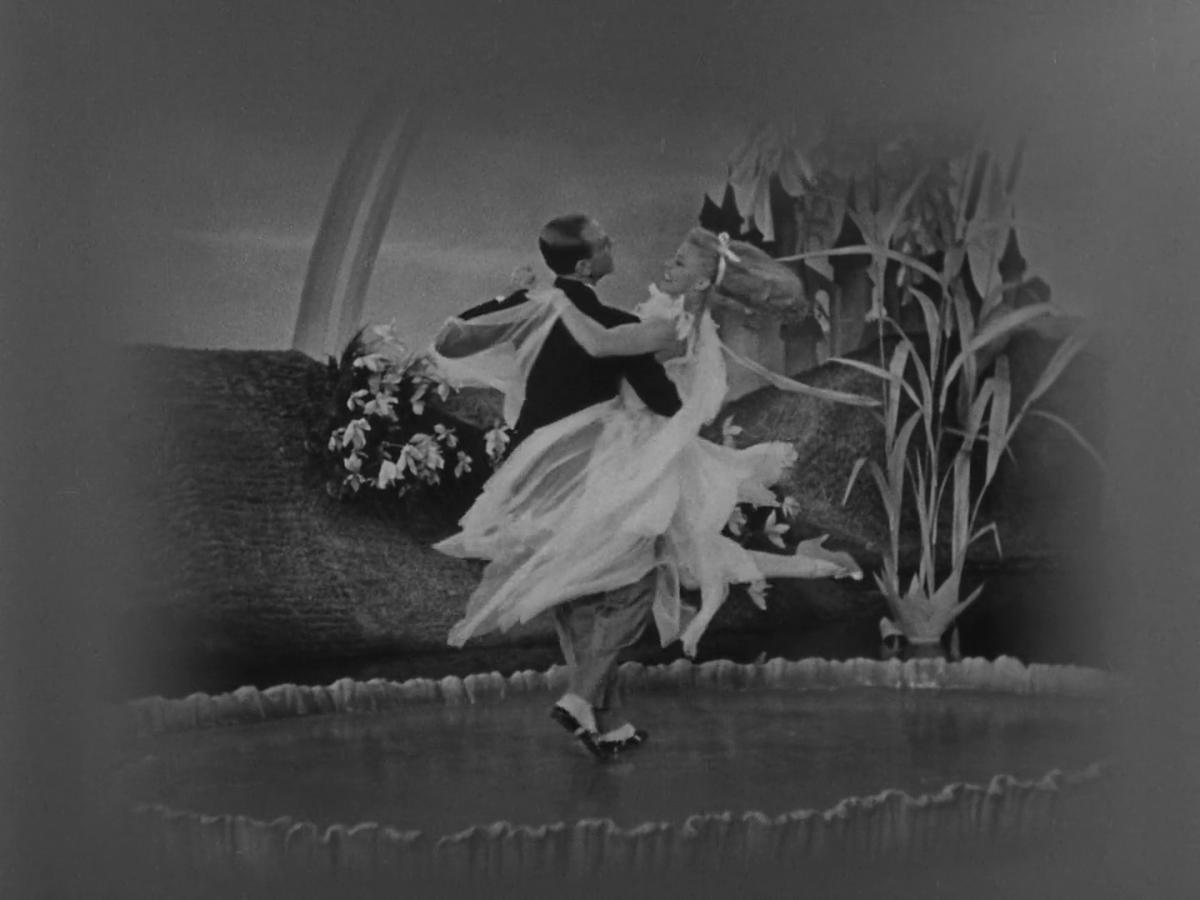
The Automaton
The theme of the puppet, the mask, the automaton, the mechanism, the silhouette runs through the series like an evil commentary (despite the charm of different versions of the theme).
Any virtuosity suggests something inhuman, seems diabolic. Astaire’s makes no exception – especially in his brilliant solo acts. There is something wooden and angular in the way he strides forward, torso and legs somehow disconnected. His countenance (“in spite of his enormous ears and bad chin line”)11 seems a pale, sickly, ghastly clown mask, a miscellany of college boy and pierrot. His appearance combines clumsiness and elegance. Clumsiness superimposed upon all the elegant, controlled sophistication as a superior, dandy-like touch (rather than, conversely, sophistication as a victory over clumsiness).
Astaire is constantly on the verge of becoming a mannequin, an automaton. Rogers, on the other hand, never is – and seeing her as a dummy in Shall We Dance is almost horror, seeing her mask in the hands of dozens of chorus girls in the closing act is frustrating. For in the dance team Rogers is the warmth, the sensuality, the whimsicality, the sun, versus Astaire’s somewhat cool, but especially dry, sharp sovereignty. He is the moon. In terms of dance virtuosity and interplay, however, it is of course precisely Rogers who reflects, echoes, duplicates Astaire’s power, ingenuity and elegance, like a moon!
The Gay Divorcee is as relevant for the motif of the mannequin as it is for the motif of language. Astaire and Horton play with revue glove-puppets: during the huge closing act, ‘The Continental’, a paper-cut dance couple spins on a record player, casting a moving shadow on the wall. It seems as if the act itself (17 minutes!) will never end and will fossilize into a perpetuum mobile. In Swing Time, Astaire dances opposite three of his own giant shadows (in ‘Bojangles’), in Shall We Dance an engine room inspires him to a solo (‘Slap that Bass’) and ‘Beginner’s Luck’ (the opening of Shall We Dance) is a dance to the music of a broken record player.
In Astaire, some of the 1920s “Silent Clowns” tradition still resonates: virtuosity based on body control, not body expression.12 But it is only a reverberation in an already entirely different world, in which sound, voice, song, music give a new meaning, a different place to virtuoso body control.
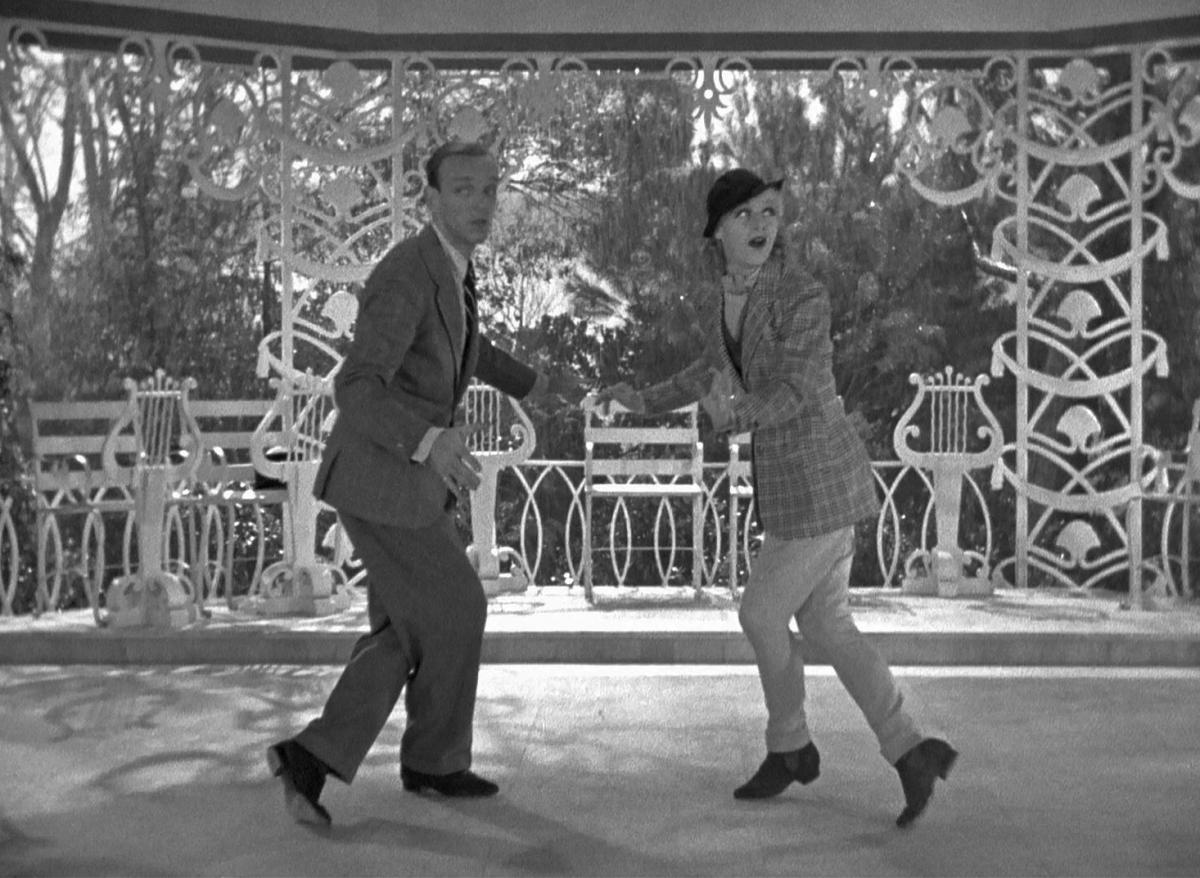
Temporality
Despite their fashionable stamp, their emphasis on the moment, despite their fragile narrative anchoring in time and space, between antecedents and perspectives, these films have a distinctly melancholic, nostalgic quality for me. It endows these noisy and inconsistent films with a kind of interiority, a density that is very unexpected in this playful, digital world of permutations.
It is a sense of time that is not driven by the diegesis (compare the first eight films in the series with The Story of Vernon and Irene CastIe, a film biography in which nostalgia is built into the very narrative). The earlier films in the series never meddled in that: no plot was ever fatal. Perhaps that is why, because everything remained so vague narratively, so focused on the moment, we only hear an irrevocable “it’s over! it’s over!” in that moment. Precisely because there is no backing, because the completion by a narrated past is missing, the melancholy of the performance itself suddenly has a chance to manifest itself.
Abruptly, a song and dance act bursts at the seams with whimsical changes, witty lines and acrobatics of understatement. It overcomes the gender divide and sweeps away the spontaneous distrust of virtuosity. This happens so abruptly that around them a cold shadow suddenly casts over all the material, as if everything was only planned so as to make song and dance all the more liberating. The dance is perceptibly preceded by a period of preparation. The dance itself, however perfect in the moment, is a culmination; it is there, gloriously in the now (only in the now). And the higher the technicity of the performance, the more intense our sense of the fragility of that performance, of its uniqueness. But if virtuosity feels inhuman, perfection feels fragile and melancholic. Anyhow, perfection is closure.
Happiness
I could describe the alienating nature of these films as a blockade (inconsistency, permutation, seriality have been some of the ways of describing and situating it). But perhaps that blockade is connected with the fundamental value of the genre, namely the negation of frustration (negation as an act of will, as a character form), from the very prelude: ‘Don’t Let It Bother You’ in The Gay Divorcee, ‘No Strings (I’m Fancy Free)’ in Top Hat and ‘Beginner’s Luck’ in Shall We Dance.
“Happiness” is a domain whose surface can be indicated, a quality that can be described. And that is what these opening acts do: claiming a space while dancing and using lyrics, melody and rhythm to describe this claim. Happiness, then, is space, not time. It is enumeration (of what one possesses, of what one is), not succession of what one should do. Happiness does not open a cycle of actions, of initiatives, of alternatives, of imperatives. It belongs to the order of observation (it is localised in the seventh and last day, the day of rest).
Where the happy ending resolves, these films begin. They are ultimately descriptions of the domain of this happiness and qualifications of the nature, tonality, rhythm, tone of this happiness. And this happiness is a total “here and now” – no yonder, no later, no earlier. Happiness is the observation: this here is my happiness. Tautology. In these films, no longing for another place, a later moment, a time in the past. Fiction here is only a prop, no longer a driving force.
My perplexity about my indeterminable place as a spectator of these films leads to a brutal conclusion: everything in these films is secondary to the primary values of virtuosity and technicity, everything is a prop, a means of reinforcing, supporting these values. Language is juggled with like a walking stick; relationships, situations, sympathies reverse as quickly as partners revolve around each other on the dance floor. These situations are sometimes extremely brutal. Marriage is trivial here (one marries in order to divorce in Shall We Dance). Emotion is a bargaining chip for superior irony.
That is not even a philosophy of the series or of the genre, it is solely the consequence of an economy of the genre. It cannot afford to let anything go unused (and thus potentially become a threat to the films’ only values: the dancing of Fred Astaire and Ginger Rogers).
There is an infectious pleasure in this playing with the unlimited changeability and usability of things. Not just of objects, but of all components of fictionality. The characters are not cynically out to profit, the genre is not critically subversive, no one assumes a worldly pose, a blasé superiority. The enjoyment of the tricks is what works here. Fiction practised like card tricks.
Theory is a poor approach to this irresponsibility. Suddenly, one notices how much morality and responsibility, how much commitment and duty each theory consumes. My perplexity may have something to do with the observation that this series, with such an inconsiderable morality and such inconsistency, manages to captivate me merely with variations.
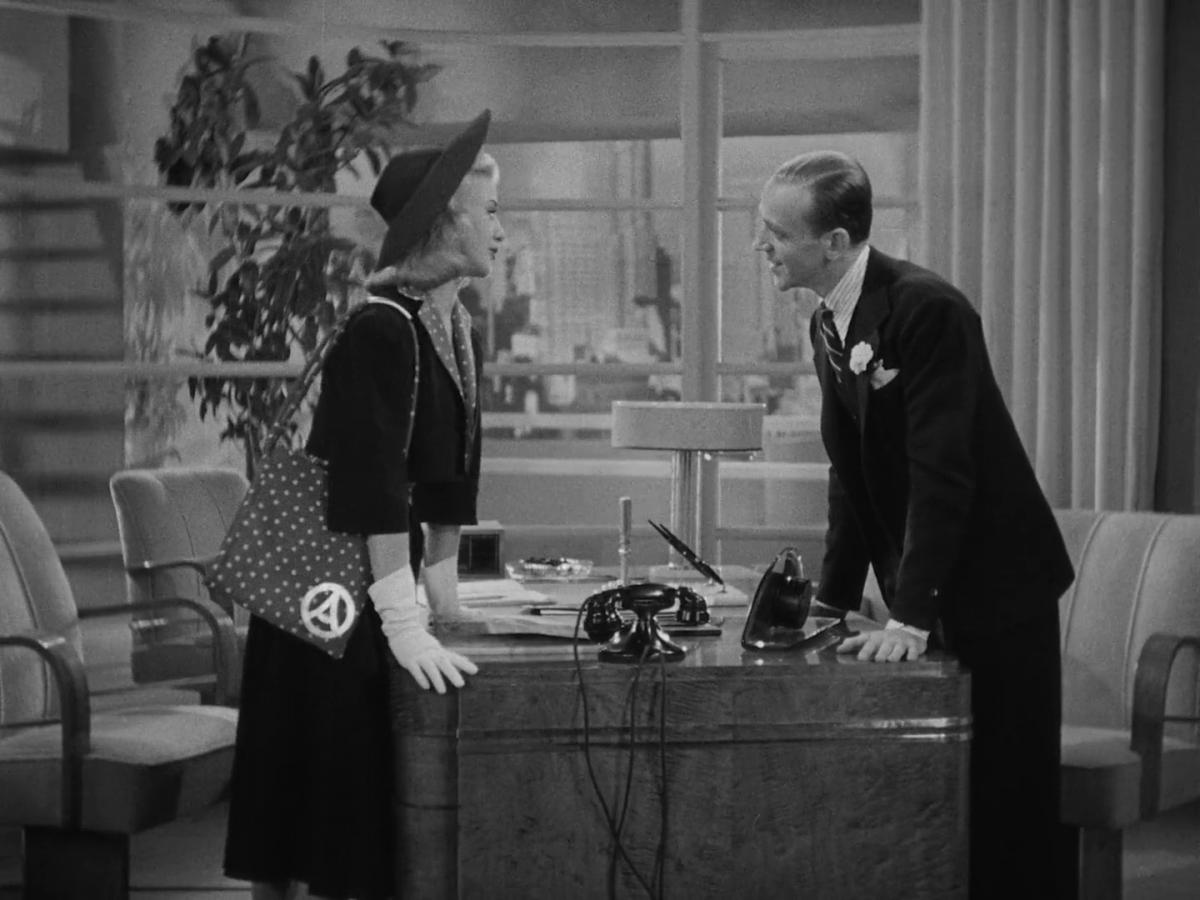
- 1While preparing, I watched seven out of ten films, missing Flying Down to Rio (the first one), Roberta (the third one) and The Barkleys of Broadway (the last one, from 1949).
- 2The substantives ‘Euphoria’ and ‘Irreverence’ fell into my lap by reading Ira Gershwin, Lyrics on Several Occasions, Elm Tree Books, London, 1977.
- 3Arlene Croce, The Fred Astaire & Ginger Rogers Book, Outerbridge & Lazard, New York, 1972.
- 4Jean-Luc Godard, in: Cahiers du Cinéma 350 (1982), p. 1.
- 5I. Gershwin, op. cit., p. 83.
- 6Fred Astaire, Steps in Time, Harper & Brothers, New York, 1959, p. 227.
- 7A. Croce, op. cit., p. 83.
- 8Idem, p. 96.
- 9Jim Collins, “Een matrix voor de muzikale comedie”, in: Versus 3/1983.
- 10John Mueller, “Fred Astaire, de verfilming van zijn dansnummers”, in: Versus 3/1983.
- 11David O. Selznick, Memo, Viking Press, New York, 1972, p. 51.
- 12Michel Leiris, “Fred Astaire”, in: Versus 3 (1983).
This text originally appeared in Versus, no. 3, 1983.
Image (1) from Swing Time (George Stevens, 1936)
Image (2) from Shall We Dance (Mark Sandrich, 1936)
Image (3) from Follow the Fleet (Mark Sandrich, 1936)
Image (4) from Flying Down to Rio (Thornton Freeland, 1933)
Image (5) from Carefree (Mark Sandrich, 1938)
Image (6) from Top Hat (Mark Sandrich, 1935)
Image (7) from Swing Time (George Stevens, 1936)

